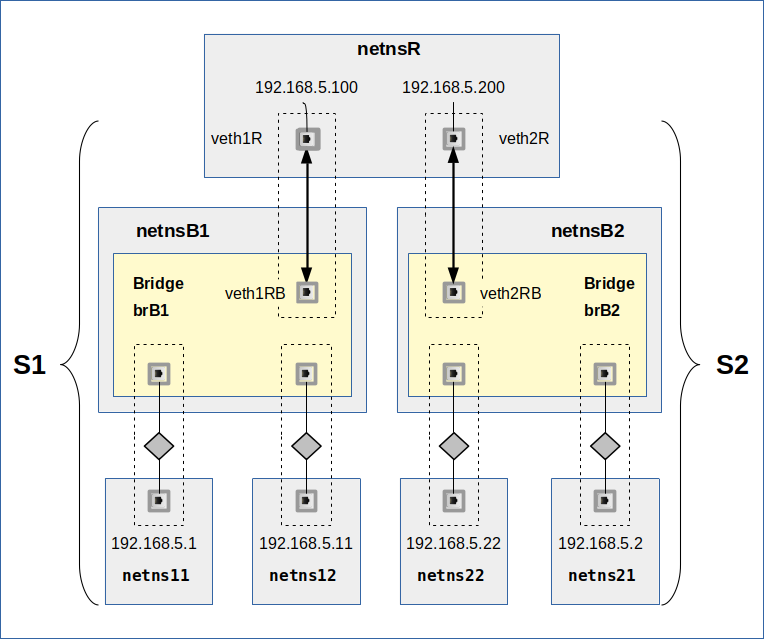Linux network namespaces allow for experiments in virtual networks without setting up (virtual) hosts. This includes the study of packet propagation through virtual devices as bridges/switches and between network namespaces. With or without packet filters or firewall rules in place. In the first posts of this series
More fun with veth, network namespaces, VLANs – I – open questions
I have posed a scenario with two L2-segments connected to a common network namespace. Such a scenario appears to be nothing special; we all are used to situations that require routing and forwarding because LAN-segments belong to different IP-subnets.
However, in my scenario all IPs are members of one and the same IP-subnet. An other interesting point is that the assignment of IPs to (virtual) NICs and bridges by the command “ip addr add” causes an automatic setup of elementary routes. We will see that such routes are insufficient to resolve the ambiguities of packet transport from the segment-coupling namespace to the attached segments.
To keep the conditions as plain and simple as possible in our scenario we do not yet mix in VLANs or packet filters or firewalls.
In the 2nd post named above we have already come to some conclusions about the posed scenario and its elements. However, these conclusions were based on theoretical considerations. In this post and in two additional ones we will verify or falsify our preliminary conclusions by performing concrete experiments on a Linux host.
The host I used for the experiments below was a laptop with an Opensuse Leap 15.5 OS, based on packets of SuSE’s enterprise server SLES. The namespaces are set up as unnamed network namespaces. This requires some special commands.
The detailed analysis of the scenario will help us to better understand more complex configurations including virtual VLANs in forthcoming posts. In particular the impact of routes on ARP traffic.
If you notice varying MACs in some images below: You may ignore this safely. It is due to repeating the setup in the course of the experiments. If you have any doubts just repeat the experiments with the help of the commnds provided in the text and in an attachment.
The scenario
The scenario is visualized by the following drawing:
I have already described details in the 2nd post listed above.
How to setup the network namespaces and required devices?
I have discussed all commands required to configure such scenarios with unnamed Linux network namespaces in the first post of another older post series. See
Fun with veth-devices, Linux bridges and VLANs in unnamed Linux network namespaces – I
If you are new to experiments with unnamed Linux network namespaces please read this post first. Of particular importance are the commands
- unshare …
- nsenter …
- ip link …
- ip address …
I will not discuss details of the chain of commands required for setting up the elements of our scenario. At the end of this post you will find three PDFs with contents you can copy to bash shell scripts. All commands in their given form are meant to be executed by the user root in a safe test environment. I am very confident that readers interested in this post will understand the structure of the commands without further explanation.
Due to the fact that the scripts set and export intermediate variables as environment variables for sub-shells you should run the scripts via the “source“-command if you want these variables to be available in your original shell (probably in a terminal window), too.
The first script (create_netns) will then execute the following commands (you may need to scroll to see all):

